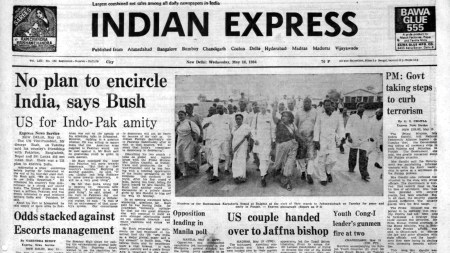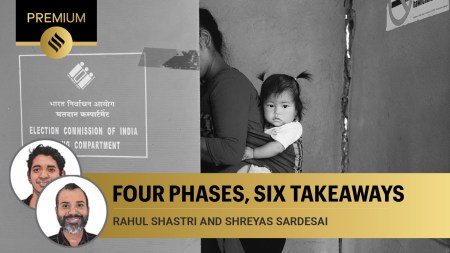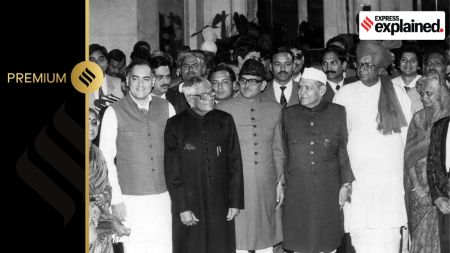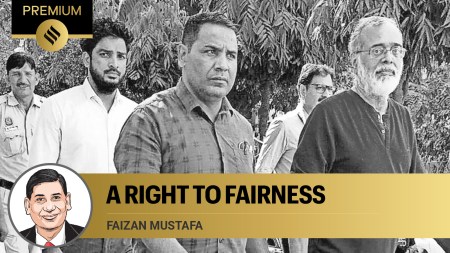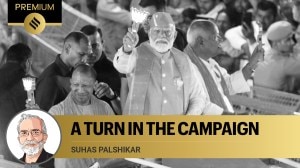- India
- International
Vijay Diwas: How India won the 1971 War in under two weeks
From officially commencing on December 3, the war lasted only 13 days, ending on December 16, celebrated as Vijay Diwas in India ever since.
 Lt Gen AAK Niazi signs the Instrument of Surrender on Dec 16, 1971, as Lt Gen Jagjit Singh Arora looks on. (Express Archive)
Lt Gen AAK Niazi signs the Instrument of Surrender on Dec 16, 1971, as Lt Gen Jagjit Singh Arora looks on. (Express Archive)On December 16, 1971, at precisely 1655 hours IST, Lt Gen AAK Niazi, Commander of the Pakistan Eastern Command, signed the Instrument of Surrender in the presence of Lt Gen JS Aurora, GOC-in-C of the Indian Eastern Command, in Dacca (now Dhaka).
This brought to an end a war which officially lasted just 13 days. Pakistan was split in two, and Bangladesh was born. The Indian Army took approximately 93,000 prisoners of war, the largest surrender of forces since World War II. And with its victory, the balance of power in the subcontinent firmly, and forever, shifted to India.
But how did India’s armed forces ensure such an overwhelming victory in under two weeks? Here is a quick recap.
The War actually began in early 1971
Tensions between East and West Pakistan had been simmering since 1947, and by early 1971, the country stood at the cusp of civil war.
On March 25, the Pakistan Army launched Operation Searchlight, with the aim to crush all political opposition in the East. Alongside Bengali nationalists, the operation also targeted the intelligentsia, academics, and Bengali Hindus — with widespread, indiscriminate extrajudicial killings. Anywhere between 300,000 and 3 million Bengalis were killed, and around 10 million refugees would flee to India.

This wanton violence, however, only spurred nationalist sentiment. Bengali civilians and military men began to fight back. Five battalions of the East Bengal Regiment mutinied, and civilians raided arms depots to help resist the onslaught by the Pak Army. Thus came to be the Mukti Bahini, a guerrilla fighting force, which by April 1971 was fairly organised, comprising both civilians and Pak Army defectors. Through 1971, the Mukti Bahini would control swathes of the countryside, and conduct successful ambush and sabotage operations.
Notably, given India’s already tenuous relations with Pakistan, and the burgeoning refugee problem in Bengal and Assam caused by the crisis, the Indira Gandhi government decided to support this resistance movement by arming and training the Mukti Bahini. Thus, the war to liberate Bangladesh, and India’s role in it, long predated the beginning of the official Indo-Pak War of 1971.
A lengthy preparation
Although some figures in the Indian government wanted immediate military intervention as early as April, India delayed its direct involvement for a number of reasons.
“A precipitate march into East Bengal would not have served the higher political aim of securing international recognition for Bangladesh,” Chandrashekhar Dasgupta wrote in India and the Bangladesh Liberation War (2021). Many in India feared hasty Indian intervention would drown any sympathy that Bangladesh had evoked in the din of an Indo-Pak war.
Thus, India wanted to first establish the legitimacy of Bengali resistance and the provisional Bangladeshi government that had been operating from Kolkata. Moreover, Mukti Bahini’s guerrilla tactics were perfect to soften Pakistan up for an eventual invasion.
Most importantly, however, India was simply not prepared to fight a war against Pakistan on its eastern front. Thus far, it had only ever engaged with Pakistan in the west, with India’s Eastern Command more concerned with dealing with Chinese aggression and countering insurgencies in the northeast.
“India’s unpreparedness to fight a war in East Pakistan is vividly illustrated by the fact that when the Eastern Command began to draft its operational plans in April, it discovered that maps of East Pakistan in its possession were over fifty years old, dating back to the British Raj,” Dasgupta wrote.
Thus, India spent months in planning and preparation before actually entering the War. This would eventually bear fruit, as the Indian military plan was executed almost faultlessly when the war actually began.
A decisive victory
Although border shelling had ramped up, and the Indian forces had conducted various limited operations in the preceding months, the War began on December 3 when Pakistan decided to carry out pre-emptive air strikes on eight Indian airfields. That evening, Prime Minister Indira Gandhi announced on AIR that the airstrikes were a “declaration of war against India.”
But the Pakistanis did not inflict much damage, and failed to limit India’s ability to fight the War. India was able to immediately cease the advantage.
A surprise attack on the Karachi harbour by the Navy crippled its Pakistani counterpart’s ability to have a serious impact on the War. A naval blockade of East Pakistan cut off supplies and reinforcements. And the Pak Air Force was “blown out of the skies” within the first week of the War.
On the ground, the Indian Army adopted blitzkrieg tactics in the East, conducting a three-pronged assault, and bypassing and isolating Pakistani positions that were deemed not crucial. Simultaneously, it held off Pakistani attacks in the West, and in fact made territorial gains of its own.
“The outcome of the conflict on the eastern front after 6 December was not in doubt, as the Indian military had all the advantages. Its force was considerably larger, much better armed, more mobile, and had complete control of the air and sea,” Richard Sisson and Leo E Rose wrote in their classic War and Secession: Pakistan, India, and the Creation of Bangladesh (1990).
“The Pakistani forces, in contrast, were cut off from the outside world and had insufficient supplies.. [and] had to deal with a basically hostile local populace, while the Indians, acting through the Mukti Bahini and the Awami League, had excellent local intelligence,” they wrote.
After surrounding Dacca on December 16, the Indian Army issued an ultimatum to surrender in 30 minutes. With zero hopes of a victory, Lt Gen Niazi obliged, without offering any resistance.
More Explained
EXPRESS OPINION
May 19: Latest News
- 01
- 02
- 03
- 04
- 05



